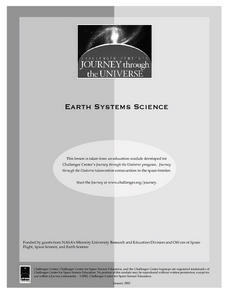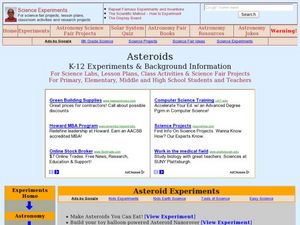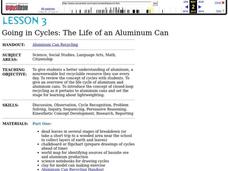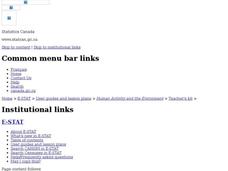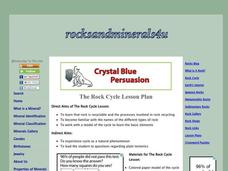Curated OER
Volcano!-Is That a Volcano on Your Plate?
Young scholars explore how and where volcanoes form. They also explore how the interactions between oceanic and continental crust create volcanoes and other mountains and earthquakes in a simulation activity using cardboard of two...
Curated OER
Volcanoes And Atmospheres
High schoolers identify the volcano as the primary source of atmospheric gases, to explain the formation of ozone, and to recognize the dangers of volcanic gases through the use of technology in the classroom.
Curated OER
Weather: It Works, or Not?
Young scholars discover the techniques meteorologists use to examine the atmosphere. In groups, they build their own weather station and observe the various weather conditions. They identify the types of weather patterns that allow the...
Curated OER
Volcano!-Thar She Blows!
Middle schoolers describe how volcanoes are formed. They name the types of boundaries where volcanoes occur. They utilize models to illustrate the occurence of volcanoes and earthquakes along plate boundaries. They compare and constrast...
Curated OER
Asteroids
Young scholars examine a potential asteroid impact site. They describe evidence and theories for extinction events.
Curated OER
Getting to Know Soil
Students make predictions and analyze soil. In this soil properties instructional activity, students make predictions about soil properties for various soil samples. Students examine the types of soils and record their observations....
Curated OER
Planetary Weather
Students study the weather on other planets in our solar system. In this planetary weather lesson students create a display of the different weather conditions on the other planets.
Curated OER
My Friend, The Volcano
Young scholars describe the positive impacts of volcanic activity on marine ecosystems. In this volcano lesson students explore the process that causes volcanic activity along the Mariana and Kermadec Island Arcs.
Curated OER
Modeling Oil and Gas Reservoirs
Students investigate energy by researching how oil reservoirs work. In this fossil fuels lesson plan, students conduct an experiment using a half full bottle of water, corn oil and oxygen, recording their data as the elements are mixed...
Curated OER
It looks Like Champagne
Students interpret phase diagrams and explain the meaning of vocabulary words. In this ocean explorer lesson students describe two uses of super-critical carbon dioxide.
Curated OER
Carving Mountains
Students explore geography by participating in an illustration activity. In this land-form lesson, students define vocabulary terms associated with glaciers and forests. Students utilize pens, cardboard and pottery clay to draw and...
Curated OER
Going in Cycles: The Life of an Aluminum Can
Students investigate the manufacture of aluminum cans and consider the energy and resources saved when the cans are made from recycled material. They explore the concept of closed-loop recycling using charts, worksheets and discussion.
Curated OER
Sediment Deposition Lab
Students set up a stream table, observe erosion, and record data on where various sizes of sediments settle. They draw conclusions as to what kind of sedimentary rock form in what locations.
Curated OER
Going in Cycles: The Life of an Aluminum Can
Students explore the life cycle of aluminum cans. In this recycling lesson, students review the manufacturing process and how to make a closed loop cycle. Students also have the opportunity to present what they've learned to others...
Curated OER
Solid Waste in Canada
Students develop an understanding of waste and its effects. For this managing waste lesson students participate in one of a few activities including creating a poster, summarizing an article or writing a research paper.
Curated OER
Processes of the Rock Cycle
Students explore, predict, and create each major rock form (sedimentary, metamorphic, and igneous) with colored modeling clay, discover cycle of rock formation, and examine important relationships of heat and pressure in rock development.
Curated OER
Who Was Here First? Relative Dating
Students read about and complete question activities for the topic of relative dating. In this relative dating lesson, students read information for the topic and then complete two activities to further their understanding of geologic...
Curated OER
The Ozone Between Us
Students investigate how ground level ozone occurs in many areas of the country. They study the ozone problems that are associated with population centers.
Curated OER
Structural Geology Laboratory
Students explore modeling of geologic structures in experiments. They study how compressive and tensile forces produce these structures. The compression makes the flatlying strata shorter and tension make the strata longer.
Curated OER
What is the Rock Cycle?
Students investigate the rock cycle. In this geology lesson, students read about the rock cycle on a website and discuss the steps of the rock cycle. Students visit a rock cycle website to complete a quiz. This is the first introductory...
Curated OER
The Rock Cycle
Students study the rock cycle of different types of rock. They arrange cut-outs of the parts of the rock cycle in the correct order and then draw the rock cycle or research different types of rocks.
Curated OER
Rocks and Minerals: Sedimentary Rocks
Students explore the concept of rock formation. In this sedimentary rocks lesson, students observe and record their findings about sedimentary rocks. Students then create limestone, coal, and sandstone models and write reports...
Curated OER
Plates on the Move
Young scholars explore how Africa appears to be tearing apart from Asia and tha the other continents are moving and oceans are changing size.
Other popular searches
- Science Earth Layers
- Earth Science Earth's Layers
- Earth Science Earth Layer
- Science Layers of the Earth





